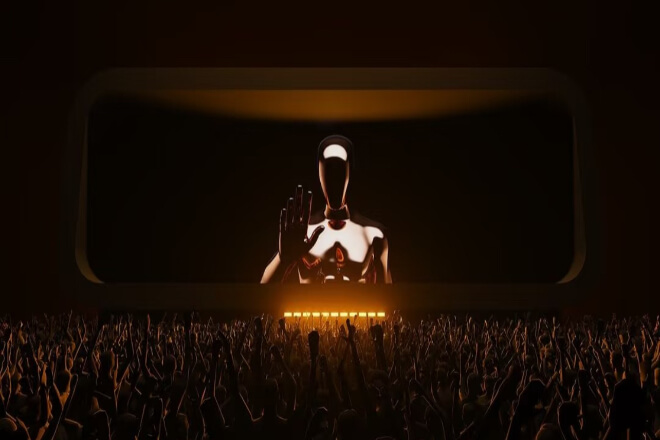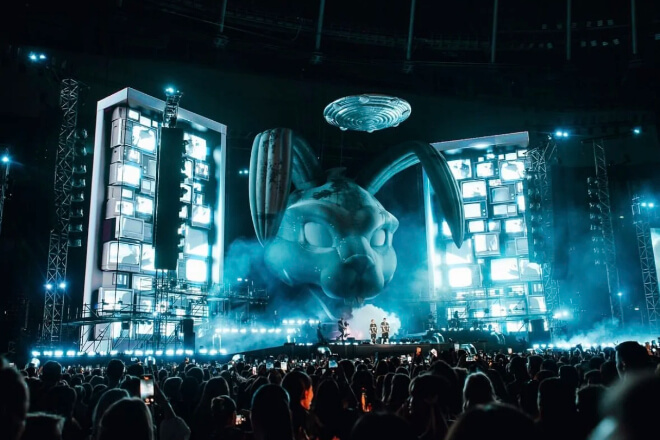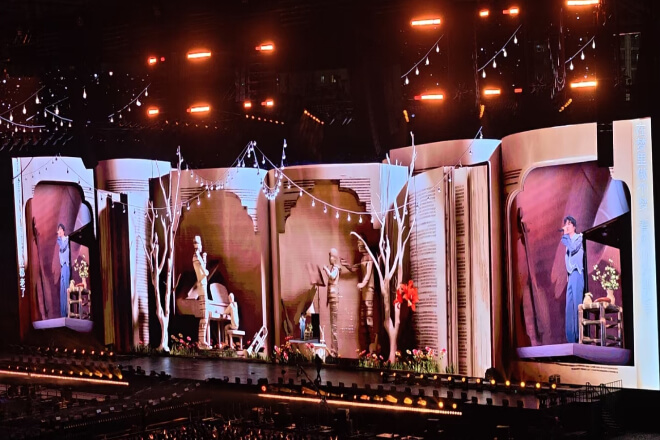مقدمة
في العروض المسرحية اليوم، شاشات عرض LED ثلاثية الأبعاد بالعين المجردة أصبحت أداة رئيسية لتعزيز التأثيرات البصرية.
ولكن كيف نضمن أن تُحدث هذه الأجهزة المتطورة أفضل تأثير على المسرح؟ ستكشف هذه المقالة عن النقاط الرئيسية التي يجب مراعاتها عند استخدام شاشات عرض LED ثلاثية الأبعاد بالعين المجردة على المسرح.
جدول المحتويات
البند 1: موضع التركيب وزاوية شاشات العرض LED ثلاثية الأبعاد بالعين المجردة على المسرح

1) تخطيط معقول لموضع التثبيت
1.1). حدد موضع التثبيت وفقًا لـ منصة الحجم والشكل
بالنسبة للمسارح الكبيرة، يتم تثبيت شاشة العرض الرئيسية فوق مركز المسرح، على ارتفاع حوالي 5-8 أمتار وحوالي نصف عرض المسرح، حتى يتمكن الجمهور من الرؤية بوضوح.
يتم تثبيت شاشات العرض المساعدة على كلا الجانبين، بزاوية 30-60 درجة بين شاشة العرض الرئيسية وشاشة العرض الرئيسية، بحيث يمكن للجمهور على كلا الجانبين الاستمتاع أيضًا بتأثير ثلاثي الأبعاد.
بالنسبة للمراحل الصغيرة، يتم تثبيت شاشة العرض الرئيسية في الخلفية، بارتفاع 2-4 أمتار وعرض يتراوح بين ثلث إلى نصف عرض المسرح.
شاشات العرض المساعدة هي شاشات صغيرة الحجم ويمكن تركيبها على الأعمدة أو الجدران على كلا الجانبين.
إذا كان المسرح في شكل غريب، مثل المسرح الدائري، يتم تثبيت شاشة العرض الرئيسية على القوس العلوي المركزي، وتحيط شاشة العرض المساعدة بدائرة أو قوس على طول الحافة لضمان أن يتمكن الجمهور من رؤية التأثير ثلاثي الأبعاد من جميع الزوايا.
1.2). مراعاة التنسيق مع العناصر الأخرى للمرحلة
عند تركيب شاشة عرض LED ثلاثية الأبعاد بالعين المجردة، تجنب الأماكن التي يضيء فيها الضوء بشكل مباشر.
سيؤدي الضوء المباشر إلى انعكاس الضوء على شاشة العرض، وستبدو الصورة غير واضحة، وسيكون اللون غير دقيق.
يمكنك ضبط زاوية الإضاءة أو إضافة طبقة مضادة للانعكاس إلى شاشة العرض.
وفي الوقت نفسه، سطوع يجب أن يتطابق سطوع شاشة العرض مع سطوع إضاءة المسرح؛ وإلا، فسوف تكون شديدة السطوع والبهتان أو خافتة للغاية بحيث يصعب رؤيتها بوضوح.
أثناء العروض المسرحية، يجب تنسيق وضع وتحريك الدعائم مع موضع شاشة العرض.
على سبيل المثال، في مسرحية موسيقية، إذا كانت هناك مجموعة كبيرة من الدعائم تتحرك على المسرح، فلا يمكن حجب شاشة العرض بواسطة الدعائم.
إذا كان من الضروري أن تمر الدعامات أمام شاشة العرض، فاستخدم شاشة عرض شفافة أو شاشة عرض متحركة.
عندما تتحرك الدعائم، ستقوم شاشة العرض بتعديل موضعها لضمان عدم تأثر رؤية الجمهور.
2) تحديد الأفضل زاوية الرؤية
2.1) تحديد نطاق الزاوية وفقًا لخصائص تقنية الرؤية ثلاثية الأبعاد بالعين المجردة
تحقق شاشة العرض LED ثلاثية الأبعاد بالعين المجردة تأثيرًا ثلاثي الأبعاد يعتمد على مبدأ المنظر.
بالنسبة لشاشة العرض ذات تقنية العدسات الأسطوانية، فإن أفضل زاوية رؤية هي حوالي 30-40 درجة في الاتجاه الأفقي و20-30 درجة في الاتجاه الرأسي.
بالنسبة لشاشة العرض ذات تقنية حاجز الضوء، فإن أفضل زاوية عرض في الاتجاه الأفقي تكون أضيق قليلاً، حوالي 20-30 درجة، والاتجاه الرأسي مشابه.
وبعيدًا عن هذه الزوايا، تصبح الصورة عرضة للتشويه وتشويه الألوان، كما يتدهور تأثير الأبعاد الثلاثية.
2.2). اضبط زاوية التثبيت وموضعه لتوسيع نطاق التغطية
تتم إمالة شاشة العرض الرئيسية بمقدار 10-20 درجة باتجاه القاعة حتى يتمكن الجمهور في مواقع مختلفة من رؤية تأثيرات ثلاثية الأبعاد بشكل أفضل.
يمكن لشاشة العرض المساعدة أيضًا ضبط زاوية الميل وفقًا لموضع التثبيت وتخطيط القاعة.
يمكن أن يؤدي تغيير ارتفاع التثبيت وموضع شاشة العرض أيضًا إلى توسيع نطاق تغطية أفضل زاوية عرض.
على سبيل المثال، إذا تم خفض ارتفاع شاشة العرض الرئيسية بشكل مناسب، فسيتمكن كل من الجمهور في الصف الأمامي والخلفي من رؤية تأثيرات جيدة.
يتم تعديل ارتفاع التركيب وموضع شاشة العرض المساعدة وفقًا لميل القاعة وتوزيع المقاعد بحيث يمكن للجمهور في مناطق مختلفة أن يكونوا ضمن نطاق زاوية الرؤية الأفضل.
البند 2: اختيار الأجهزة لشاشة عرض LED ثلاثية الأبعاد بالعين المجردة على المسرح

1) شاشة العرض دقة و مساحة وحدة الصورة
تتمتع شاشة LED ثلاثية الأبعاد عالية الدقة بالعين المجردة، مثل الصور الملتقطة بكاميرا عالية البكسل، بصورة واضحة ودقيقة بشكل خاص.
ومع ذلك، فإن حجم البكسل مهم جدًا أيضًا، وهو يشبه المسافة بين "النقط" على الشاشة.
كلما كان حجم البكسل أصغر، كانت هذه "النقاط" أكثر كثافة، وكانت الصورة أكثر وضوحًا، تمامًا مثل النمط الدقيق المطرز بغرز دقيقة.
إذا كان المسرح كبيرًا والجمهور بعيدًا، فيمكن أن تكون درجة البكسل أكبر قليلًا.
على سبيل المثال، تعد شاشات العرض P6 وP5 مناسبة للعرض على مسافات طويلة، مما يمكنها من التحكم في التكاليف بشكل فعال مع ضمان الوضوح الأساسي للصورة.
إذا كان المسرح صغيرًا والجمهور قريبًا، فيجب عليك اختيار نماذج ذات مساحة بكسل صغيرة، مثل P2.5 وP2 وP1.98.
تجعل دقة البكسل الصغيرة الصورة أكثر دقة وتسمح للجمهور برؤية التفاصيل بوضوح.
2). سطوع وتباين شاشة العرض
الأضواء على المسرح متنوعة، أحيانًا تكون ساطعة جدًا وأحيانًا أخرى تكون داكنة.
في مثل هذه البيئة المعقدة، يجب أن تكون شاشة العرض ساطعة بدرجة كافية بحيث يمكن رؤيتها بوضوح في ظل ظروف الإضاءة المختلفة، ولن تكون تفاصيل الصورة غير واضحة بسبب الضوء القوي للغاية.
تخيّل أنه إذا كانت الصورة مظلمة جدًا، فسينظر الجمهور إلى الزهور وسط الضباب ولن يتمكنوا من رؤية أي شيء بوضوح. لذلك، تُعد شاشة العرض عالية السطوع أمرًا بالغ الأهمية.
علاوة على ذلك، يُعدّ التباين بالغ الأهمية. فشاشة العرض عالية التباين تُبرز طبقات الصورة وعمقها بشكل أوضح.
على سبيل المثال، ستجعل الصورة ذات التباين العالي اللون الأسود أكثر سوادًا، والأبيض أكثر بياضًا، وسيكون الانتقال في المنتصف أكثر طبيعية، وسيكون تأثير ثلاثي الأبعاد أكثر واقعية.
إن اختيار شاشة عرض ذات تباين عالٍ يمكن أن يجعل التأثير البصري للأداء المسرحي أكثر إثارة للصدمة، ويترك انطباعًا عميقًا لدى الجمهور ويجعلهم يشعرون وكأنهم هناك.
البند 3: اختيار مصدر الفيديو لشاشة عرض LED ثلاثية الأبعاد بالعين المجردة على المسرح

1) نوع مصدر الفيديو
هناك العديد من مصادر الفيديو للاختيار من بينها لشاشات العرض LED ثلاثية الأبعاد بالعين المجردة المستخدمة على المسرح.
إذا كنت تريد تأثيرًا جيدًا، فإن مصدر الفيديو ثلاثي الأبعاد متعدد وجهات النظر جيد جدًا؛ حيث يمكن رؤيته من زوايا مختلفة، كما أن الإحساس ثلاثي الأبعاد قوي للغاية.
هناك أيضًا مصادر فيديو ثلاثية الأبعاد ثنائية العين تلبي مواصفات BT.2160، وهي مصممة خصيصًا للعرض ثلاثي الأبعاد وتتمتع بتأثيرات رائعة.
تتوفر أيضًا تنسيقات (V+D) يمكن استخدامها على شاشات LED ثلاثية الأبعاد بالعين المجردة. ولكل منها مزاياها الخاصة.
2) دقة مصدر الفيديو
من المهم أن يكون لديك مصدر فيديو عالي الدقة، تمامًا كما يجب أن تكون الصورة ذات البكسلات العالية واضحة.
يمكن لمصادر الفيديو عالية الدقة أن تجعل الصورة أكثر وضوحًا ودقة، ويمكن رؤية المشاهد والتفاصيل المعقدة ثلاثية الأبعاد بوضوح.
إذا تمكنت من استخدام مصدر فيديو عالي الدقة 4K أو أعلى، فسوف تتحسن وضوح وانغماس التأثير ثلاثي الأبعاد بشكل كبير، وسيكون الجمهور أكثر متعة للمشاهدة.
3) توافق مصدر الفيديو
عند اختيار مصدر فيديو، عليك أيضًا التأكد من توافقه مع أجهزة العرض ثلاثية الأبعاد LED بالعين المجردة.
بعض تنسيقات مصادر الفيديو أكثر خصوصية وقد تتطلب معدات معالجة خاصة للتعامل معها.
تتوافق أجهزة المعالجة هذه مع مصادر الفيديو بتنسيقات متعددة، ويمكن أيضًا تحسينها وفقًا لخصائص شاشة العرض.
حتى يتمكن مصدر الفيديو من تقديم أفضل تأثير على شاشة العرض.
4) تخصيص مصدر الفيديو
بالنسبة للمشاهد المحددة، مثل العروض المسرحية، من الأفضل تخصيص مصدر الفيديو.
يمكنك التخطيط لتأثير ثلاثي الأبعاد لمصدر الفيديو بالتفصيل وفقًا للموضوع والأسلوب ومخطط الأداء.
البند 4: التحكم المتزامن في شاشة LED ثلاثية الأبعاد بالعين المجردة على المسرح

1) المزامنة في الوقت الفعلي مع العروض المسرحية
عند استخدام شاشة LED ثلاثية الأبعاد بالعين المجردة على المسرح، يجب أن يتطابق تبديل الشاشة وتأثيرات الرسوم المتحركة مع إيقاع الأداء.
على سبيل المثال، عندما تصل الموسيقى إلى ذروتها، تتغير الصورة إلى مشهد ثلاثي الأبعاد مذهل للغاية أو تتغير بسرعة كبيرة لإضاءة عيون الجمهور.
إذا تباطأ إيقاع الموسيقى، تصبح الصورة مستقرة وناعمة، مما يخلق جوًا مماثلًا.
يمكن استخدام نظام التحكم في المزامنة الاحترافي لتوصيل شاشة العرض بإضاءة المسرح والصوت بحيث يمكن تحقيق تأثير المزامنة المثالي.
على سبيل المثال، عندما يقوم أحد الممثلين بأداء عمل معين، يمكن لشاشة العرض التبديل إلى المشهد ثلاثي الأبعاد المقابل بشكل متزامن، مما يجعل الأداء يبدو أكثر واقعية.
2) الربط والتنسيق بين الشاشات المتعددة
إذا تم استخدام شاشات LED ثلاثية الأبعاد متعددة للعين المجردة على المسرح، فمن الضروري التأكد من إمكانية عرض صور هذه الشاشات والتبديل بينها بشكل متزامن.
استخدم تقنية الاتصالات الشبكية لتوصيل شاشات متعددة لتحقيق ربط متعدد الشاشات.
عند ربط شاشات متعددة، انتبه إلى تأثيرات الوصل والانتقال للصور.
جعل صورة المسرح بأكملها تبدو متماسكة وطبيعية، دون علامات ربط واضحة، ودون تأخير الصورة، وذلك لضمان أن يكون التأثير الذي يراه الجمهور مثاليًا.
5. الخاتمة
من خلال مقدمة هذه المقالة، أعتقد أن لديك فهمًا أوضح للنقاط الرئيسية لاستخدام شاشات LED ثلاثية الأبعاد بالعين المجردة على المسرح.
سواء كان الأمر يتعلق بالتخطيط الدقيق لموقع التثبيت، أو التحكم الصارم في اختيار الأجهزة، أو المطابقة الدقيقة لمصادر الفيديو والتنفيذ الدقيق للتحكم المتزامن، فإن كل التفاصيل تؤثر على تأثير المرحلة النهائية.
أخيرًا، إذا كنت تريد معرفة المزيد عن شاشات LED، يرجى الحصول على اتصال معنا.
